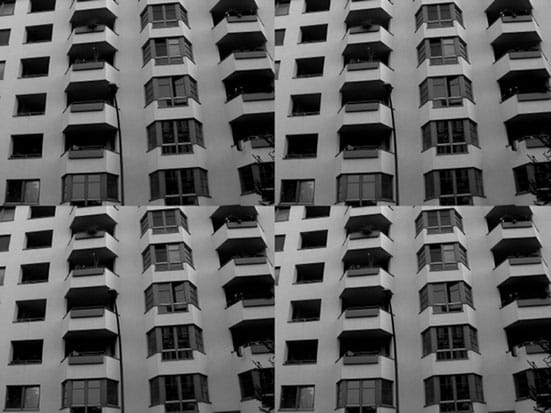6th September 2007 — 4th October 2007
Hollybush Gardens is surprisingly, deceptively small. As Wilkinson
unveil their monolithic House of Usher on Vyner Street, it is
heartening to walk down the road and climb a couple of flights to this
studious, studio-like, faintly municipal gallery space. Karl
Holmqvist's first solo exhibition in London consists of three major
new works, and two prints; exhibited with simple, allied clarity. The
partial working aesthetic of the space lends itself perfectly to the
pieces on show – there is a distinctly relational aspect to the works'
appeal for dialogue, as continuing and unfinished. Holmqvist's
practice is crowded with subjectivities – the artist; the audience;
the works themselves – and its' expression is necessarily choral in
discipline and unsigned thematic models.
The first piece in the exhibition is a video entitled House Music.
Four minutes of rapidly changing black and white photos appear in
symmetrical, geometric formations upon the screen, and are accompanied
by stark German techno. The images are of a civic architecture common
in East Berlin – 'Plattenbauten' (literally, 'slab-buildings') – the
preferred means of public-housing in the former German Democratic
Republic, due to their cheap and speedy assemblage. The
'Plattenbauten' photos in the video are mirrored, rotated and
splintered, emphasising their numbing ubiquity, but equally testifying
to a humanitarian essence completely divorced from the buildings'
original utilitarian purpose: they are a backdrop for cultural and
social innovation. The form of the music video, the techno soundtrack
and the titular 'house music', conduct dialogues with a lineage of
peculiarly German musical movements, from 'kosmische musik', Kraftwerk
and the 'Berlin school', to electro, heavy metal and minimal techno.
They engage with an urban, industrialised and uniform aesthetic.
Pattern and repetition provide the compositional framework for much of
Holmqvist's work, often in the form of civic design and purpose
juxtaposed with inevitable entropy by prolonged misuse and
intervention. Monochrome is Holmqvist's preferred palette, evoking a
primal base for patterning: binary division. However, this emphatic
economy of subtlety perversely serves to highlight the joyous
diversity behind the stylistics.
The two, framed prints in the exhibition are graphical variations on
mandalas: a traditional Dharmic symbol that represents the cosmos in
its entirety. The absurdity of such a simple signifier of an eternally
inexpressible concept is further compounded by Holmqvist's minimal
expression. Holmqvist's semiotic perversion is a denial of denotative
meaning. The context, instead, informs the stylistics of any one
piece, generating an aesthetic impression rather than meaning.
The sculpture Queenie – a steel pyramid of a diamond pattern
resembling the Mitsubishi logo – contains within it the contradictory
connotations of industry and mysticism; progress and regression;
humanity and mechanisation. Geometric shapes delineate the aesthetic
perfection of industry and control, yet also the divinity of the
mandala. These aspirational extremes, 'us and them', the mainstream
and the underground, provide the most marked conceptual binary within
the exhibition, but it's the very real coalescence and coexistence of
these factions that interests Holmqvist. It's where black and white
merge into a vast array of greys; where civic, pre-fab housing becomes
the soundboard for techno music; where the industrialised urban
environment is re-cogitated according to the stories of its
inhabitants.
A bike laden with carrier bags and other detritus is propped against
the wall beneath the windows of the gallery. The bags – all monochrome
– bulge with non-descript materials. Media for the creation of art,
perhaps. Outside one can see industrial warehouses, council estates,
garages and pound-shops. The suggested narrative conjured by the bike
– that of the artist zigzagging the city and returning to her studio
in the heart of the industrial east – provides us with a distinctly
autobiographical image of interloper and observer, confusing the
hierarchies and polarities of the state and the individual through the
shading of innumerate other positions.
EA
Hollybush Gardens
Unit 2, Bj House
10-14 Hollybush Gardens
London E2 9QP
http://www.hollybushgardens.co.uk/
Open
Thursday-Sunday, 12pm-6pm
